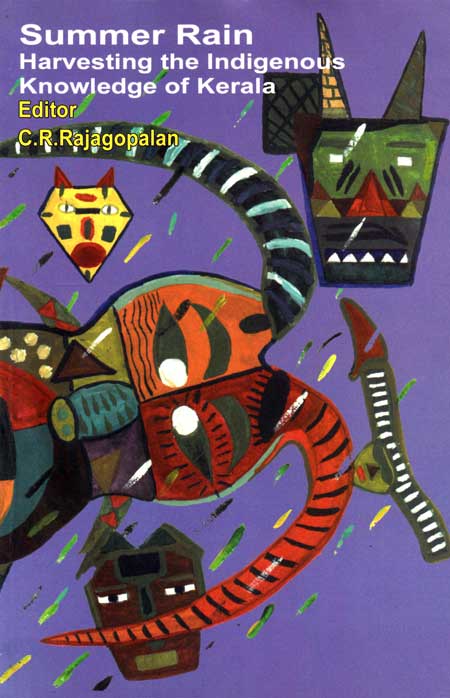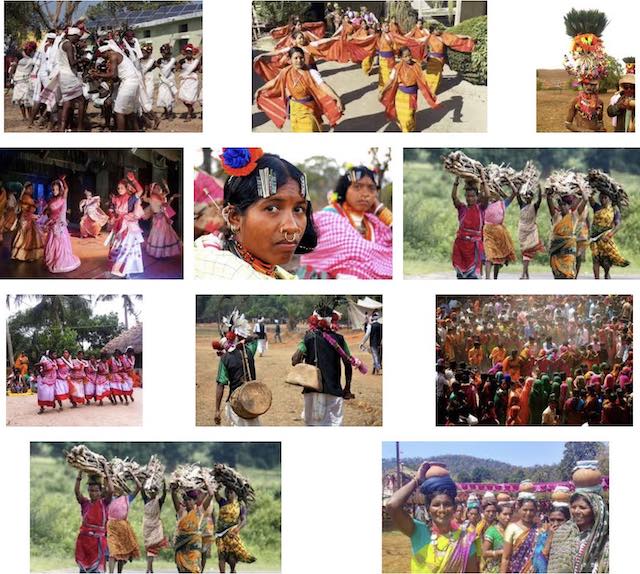
Centre for IK/Folklore Studies
Ethnobotany & ethnomedicine >>
Places like Kerala where there were numerous sacred groves and related culture, are ecologically disturbed now due to ill conceived developments chartered out by those who did not have any knowledge or concern about nature/ecology. Modernists could not understand the natural significance of the numerous rituals and myths. The tribal communities had their own thoughts and philosophy about ecological niche, and from their memory the concept of native ecology can be revived. […]
The biodiversity and the indigenous knowledge of the people about numerous varieties of seeds are the wealth of the people. Local and indigenous knowledge about soil, plants, ecology, water management, ethno zoology, ethno philosophy, ethno education, village games, local archaeology, markets, festivals, local fisheries, toxicology, agriculture, grandma medicine, rain lore, paddy lore, honey lore, sea lore, forest lore, [sacred] groves, local technologies, food, fruits, ethno music, ethno astronomy, river lore, arts and crafts etc. are now studied. This knowledge is totally different from the recorded written matter, as it lies hidden in many oral traditions. By understanding the ethnicity of every aspect cultural continuity can be traced, since the local knowledge is not “taught” but a “learned and assimilated” one. As this is a multidisciplinary area, present century will have to take immense effort in preserving and documenting it. […]
The villagers and the tribals utilised medicinal plants numbering more than eight thousand, and they practiced many systems of medicine ranging from “Grandma therapy” to sophisticated treatment. The roots of many systems of medicine like Ayurveda, Unani, Sidha can be seen in tribal medicine. Traditional veterinary and Vrikshayurveda [Arboreal or “tree-based” Medicine] also developed as a part of their holistic attitude to life. The grave crisis faced now by the third world countries is connected with the commercialisation of their indigenous knowledge by the so called developed countries and multinational agencies. From the period of colonisation the plundering of knowledge and raw materials of these countries was the aim of the west. Many formulae used in modern medicines are taken from the indigenous knowledge of the tribals of Asia, Africa and countries in South America without even a formal acknowledgement. […]
Source: C.R. Rajagopalan and V.K. Sreedharan in Summer Rain: Harvesting the Indigenous Knowledge of Kerala, pp. 15-16 & p. 93-94
“Cultivating and conserving diversity is no luxury in our times: it is a survival imperative.” – Vandana Shiva >>
“Vrksayurveda [the science on plant life] is a giant work consisting of twelve chapters. […] Just as the blood vessels carry the blood through the surface and internal parts of the body, so also there are various fountains of water in the upper and lower layers of the earth.” – C.K. Ramachanran in Vrikshayurveda: Arboreal Medicine in Ancient India >>
VRIKSHAYURVEDA (Arboreal Medicine in Ancient India)
C.K. RamachanranThis paper discusses the special branch of the Ancient Indian science on plant life as depicted by Vrikshayurveda, and the obvious relevance of the insights these provide to enrich our knowledge and practice in this field
ABSTRACT: This paper discusses the special branch of the Ancient Indian science on plant life as depicted by Vrikshayurveda, and the obvious relevance of the insights these provide to enrich our knowledge and practice in this field.
Download or view the Full Text of this article (PDF, 44K) >>
Source: Ancient Science of Life, Vol. IV, No.2 October 1984, Page 110-111 VRIKSHAYURVEDA (Arboreal Medicine in Ancient India) C.K. RAMACHANRAN, Chinganezhath House, Mavoor Road, Calicut – 673001
URL: https://www.ncbi.nlm.nih.gov/pmc/articles/PMC3331496/pdf/ASL-4-110.pdf
Date visited: 23 July 2018
“The practice of religious rituals, ceremonies and sanctions by specific cultural groups allow such sacred landscapes to be maintained, emphasizing that humans are intrinsically part of the ecosystem. Taboos, codes and customs specific to activities and community members restrict access to most sacred groves. […] The inclusion of local people’s needs and interests in conservation planning is increasingly accepted as essential, both to promote the well-being of human populations, and to ensure that biodiversity and conservation needs are met in the long-term.” – Nazir A. Pala, Ajeet K. Neg and N.P. Todaria in “The Religious, Social and Cultural Significance of Forest Landscapes in Uttarakhand Himalaya, India” (International Journal of Conservation Science, Vol. 5, Issue 2, April-June 2014) | Sacred groves | Biodiversity and development – Himalaya >>
Up-to-date reports by Indian experts and journalists
Search tips
Combine the name of any particular state, language or region with that of any tribal (Adivasi) community.
Add keywords of special interest (music, poetry, dance just as health, sacred grove and biodiversity); learn about the rights of Scheduled Tribes such as the “Forest Rights Act” (FRA); and the United Nations “Declaration on the Rights of Indigenous Peoples”, “Universal Declaration of Human Rights”, “women’s rights”, or “children’s right to education”.
Ask a question that includes “tribal” or “Adivasi”, for instance: “Adivasi way of life better?” (or “tribal way of life worse?”)
Specify any particular issue or news item (biodiversity, bonded labour and human trafficking, climate change, ecology, economic development, ethnobotany, ethnomedicine, global warming, hunter-gatherers in a particular region or state, prevention of rural poverty, water access).
For official figures include “scheduled tribe ST” along with a union state or region: e.g. “Chhattisgarh ST community”, “Himalayan tribe”, “Scheduled tribe Tamil Nadu census”, “ST Kerala census”, “Particularly Vulnerable Tribal Group Jharkhand”, “PVTG Rajasthan”, “Adivasi ST Kerala”, “Adibasi ST West Bengal” etc.
In case the Google Custom Search window is not displayed here try the following: (1) toggle between “Reader” and regular viewing; (2) in your browser’s Security settings select “Enable JavaScript” | More tips >>
Note: hyperlinks and quotes are meant for fact-checking and information purposes only | Disclaimer >>
List of websites covered by this Google custom search engine
Academia.edu (platform for academics to share research papers) – www.academia.edu
Archive.org – https://archive.org
Centre for Science and Environment – https://www.cseindia.org
Current Conservation – https://www.currentconservation.org
Development and Cooperation (D+C) https://www.dandc.eu
Down To Earth (India) – www.downtoearth.org.in
India Environment Portal – www.indiaenvironmentportal.org.in
Harnessing Nature Magazine – https://harnessingnature.online
Mongabay-India – https://india.mongabay.com
M S Swaminathan Research Foundation – www.mssrf.org
Navdanya (protecting India’s biodiversity based food heritage) – https://navdanya.org
Third World Network (Penang, Malaysia) – https://twn.my
The Shola Trust (nature conservation in the Nilgiri region) – www.thesholatrust.org

Indian online periodicals and platforms | Images view >>
~ ~ ~
Personalize your CustomSearch by combining other search words >>
(e.g. name of a tribal community and region, a craft, or dance and puppetry)
Research the above issues with the help of Shodhganga: A reservoir of theses from universities all over India, made available under Open Access >>
Note: hyperlinks and quotes are meant for fact-checking and information purposes only | Disclaimer >>
Learn more
Atree.org | Ashoka Trust for Research in Ecology & the Environment (posts)
Biodiversity | Hyderabad biodiversity pledge | Nilgiri Biosphere
Climate change | United Nations on climate change
eBook | Background guide for education
eLearning: Center for World Indigenous Studies
Health and nutrition | Recommendations by the Expert Committee
Tips for using interactive maps
Toggle to normal view (from reader view) should the interactive map not be displayed by your tablet, smartphone or pc browser
For details and hyperlinks click on the rectangular button (left on the map’s header)
Scroll and click on one of the markers for information of special interest
Explore India’s tribal cultural heritage with the help of another interactive map >>